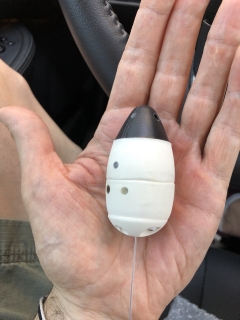Shark-saving technology makes waves
When some people think of sharks, they may conjure up an image of a menacing fin racing through the ocean in search of its next meal.
But the reality is that for most sharks, people are threatening.
According to Defenders of Wildlife, a national nonprofit dedicated to protecting imperiled species, 75% of shark species are threatened with extinction and up to 73 million sharks are being killed each year for finning.
Habitats that were once secure places for sharks to give birth have also been affected. And since sharks have long gestation periods, give birth to relatively few young and mature late in life, efforts to repopulate are made even more difficult.
Despite their menacing reputation, sharks play a significant role in balancing the ocean’s ecosystem and keeping the planet and its people healthy. Man’s survival is linked, in part, to the survival of sharks.
“If they (the mother sharks) don't have that suitable habitat, then their babies won't be able to grow up. And if babies don't grow up, we have no more sharks and literally the ocean ecosystem would collapse,” says Arizona State University Professor James Sulikowski, who has studied sharks for nearly three decades.
Much of his research takes place in the Sulikowski Shark and Fish Conservation Lab at ASU's School of Mathematical and Natural Sciences in the New College of Interdisciplinary Arts and Sciences. He has appeared on a variety of television shows, including the “Today” show, “Ocean Mysteries,” NatGeo and the Discovery Channel.
The marine biologist knows that protecting newly born shark pups would go a long way toward reversing the current trend.
And that’s exactly what he’s doing.
Sulikowski has researched and helped develop a revolutionary new satellite technology capable of remotely documenting the location and time of birth of shark pups. This data will enable the science community to create ways to protect the sharks’ vulnerable places of birth.
The device is making waves in the scientific community — and for good reason.
“We've been trying to do this since we started studying sharks. So this is really our holy grail. We have really advanced shark science 20, 30, 40 years,” says Sulikowski, who is also a senior global futures scientist and professor in the School of Life Sciences in The College of Liberal Arts and Sciences.
The process of protecting newborn sharks
In a paper released on March 1 in Science Advances, Sulikowski and his partner, Neil Hammerschlag, a marine ecologist at the University of Miami, write that “this novel technology will be especially valuable for the protection of threatened and endangered shark species, where protection of pupping and nursery grounds is a conservation priority.”
The paper outlines the deployment and results of an intrauterine satellite tag on two highly mobile sharks — a scalloped hammerhead and a tiger shark — to detect when birth occurs. They call them birth-alert tags, or BAT.
Here’s how the tags work.
First, a BAT is inserted into a pregnant shark. The egg-shaped technology is approximately 2 inches long and 1 inch wide. When the shark gives birth, the BAT pops out along with the pups and reaches the ocean surface. Once there, the device switches to transmitter mode, sending messages announcing the time and location of the birth.
The BAT has already yielded remarkable results. Where it was once assumed that sand sharks gave birth inland, the scientists have learned that they are most comfortable having their pups in abandoned shipwrecks on the ocean floor.
“It was a total surprise,” Sulikowski says. “You know, this is why we do this work. For most shark species, we have no idea where they give birth or how far they must travel to habitats that are essential for their survival.”
Once habitats are discovered, efforts will be made to protect them either by creating sanctuaries or expanding areas already set aside for this purpose.
The ultimate goal is to go global with BAT. Sulikowski wants to create a global network of shark scientists around the world to determine areas that are important to sharks and how to protect them.
Not an overnight success
The Discovery Channel will be airing an episode about Sulikowski’s research during Shark Week in July and the BAT is drawing lots of attention.
But it’s been a long and arduous effort.
“We've had every sort of failure that can happen. We had battery failures. We had firmware failures, we had antenna failures. It has taken us over six years to get to this point,” he says.
“And the only way we knew we were having failures is if the tags didn’t report, right? So there were times we waited six, seven, eight months and got nothing. … I felt like giving up multiple times. But thanks to my co-author, Neil Hammerschlag, we kept forging ahead and we didn't give up.
“And honestly, it feels incredible to have created technology that is going to revolutionize the way that we study sharks.”
Video by the New College of of Interdisciplinary Arts and Sciences
Top photo: ASU Professor James Sulikowski (left) and his team insert a birth-alert tag into a pregnant shark. The tags track the shark's birthing location to help protect nursery grounds. Photo courtesy James Sulikowski
